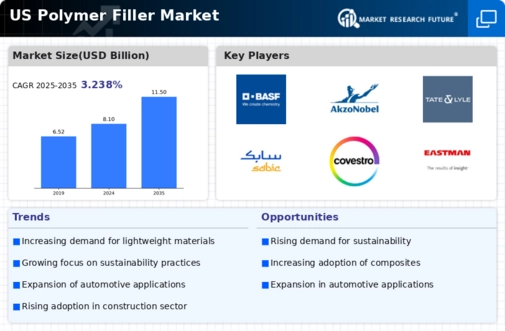The polymer filler market exhibits a dynamic competitive landscape characterized by innovation and strategic partnerships. Key players such as BASF SE (DE), DuPont de Nemours Inc (US), and Evonik Industries AG (DE) are actively shaping the market through their distinct operational focuses. BASF SE (DE) emphasizes sustainability and digital transformation, aiming to enhance product performance while reducing environmental impact. DuPont de Nemours Inc (US) is concentrating on innovation in high-performance materials, particularly in applications that require advanced polymer fillers. Meanwhile, Evonik Industries AG (DE) is leveraging its expertise in specialty chemicals to develop tailored solutions that meet specific customer needs. Collectively, these strategies foster a competitive environment that prioritizes technological advancement and sustainability.
In terms of business tactics, companies are increasingly localizing manufacturing to enhance supply chain efficiency and responsiveness to market demands. The market structure appears moderately fragmented, with several key players exerting considerable influence. This fragmentation allows for niche players to thrive, while larger corporations leverage their scale to optimize operations and expand their market reach.
In October 2025, BASF SE (DE) announced a new initiative aimed at increasing the production capacity of its eco-friendly polymer fillers. This strategic move is likely to enhance its competitive edge by meeting the growing demand for sustainable materials in various industries. The expansion aligns with global trends towards sustainability, positioning BASF as a leader in environmentally responsible manufacturing practices.
In September 2025, DuPont de Nemours Inc (US) launched a new line of advanced polymer fillers designed specifically for the automotive sector. This product introduction is significant as it reflects the company's commitment to innovation and its focus on high-growth markets. By catering to the automotive industry's evolving needs, DuPont is likely to strengthen its market position and drive revenue growth in this segment.
In August 2025, Evonik Industries AG (DE) entered into a strategic partnership with a leading automotive manufacturer to co-develop next-generation polymer fillers. This collaboration underscores Evonik's strategy to integrate closely with key customers, ensuring that its product offerings are aligned with market demands. Such partnerships may enhance Evonik's ability to innovate and respond swiftly to industry changes, thereby solidifying its competitive stance.
As of November 2025, current trends in the polymer filler market indicate a strong emphasis on digitalization, sustainability, and the integration of AI technologies. Strategic alliances are increasingly shaping the competitive landscape, enabling companies to pool resources and expertise. Looking ahead, it appears that competitive differentiation will evolve from traditional price-based competition to a focus on innovation, technological advancements, and supply chain reliability. This shift suggests that companies prioritizing these aspects may gain a substantial advantage in the marketplace.
























Leave a Comment